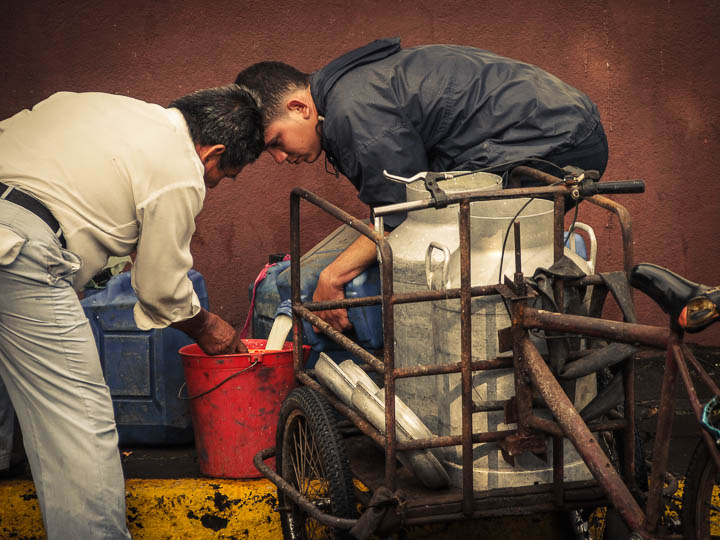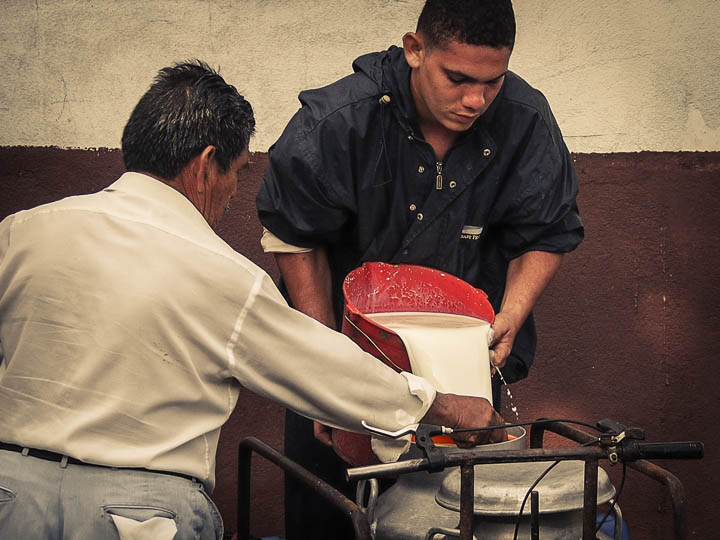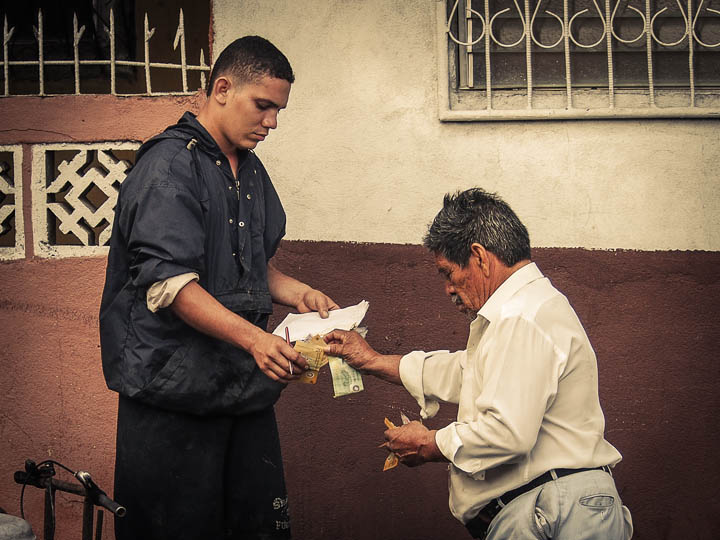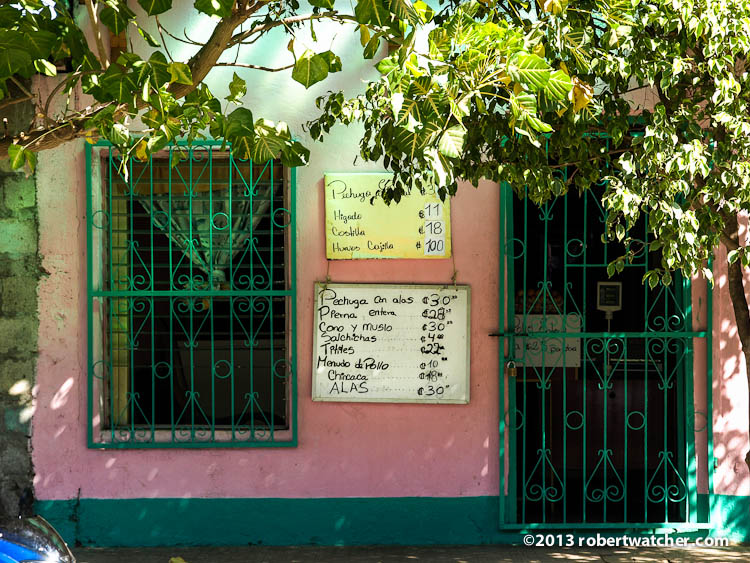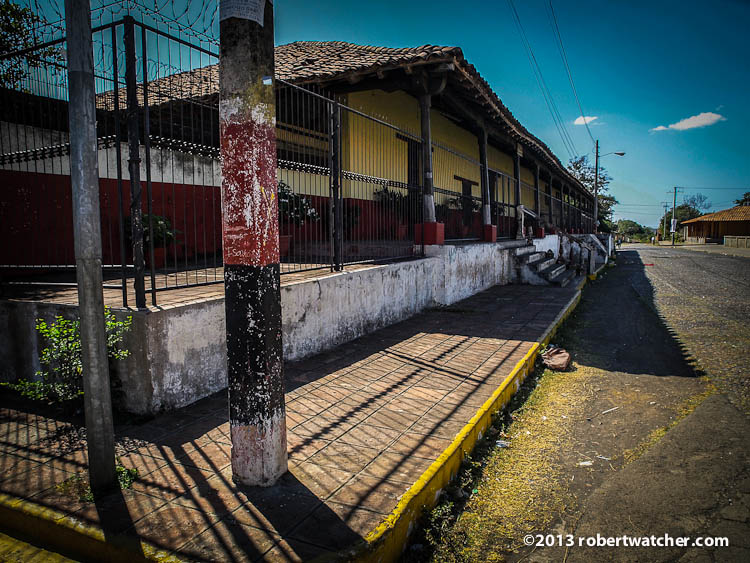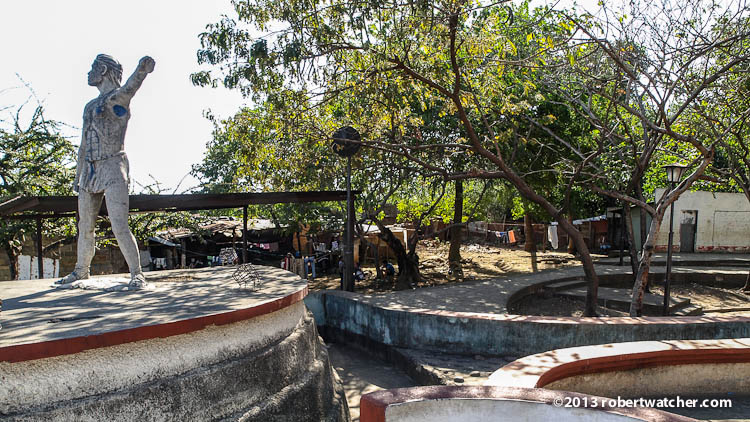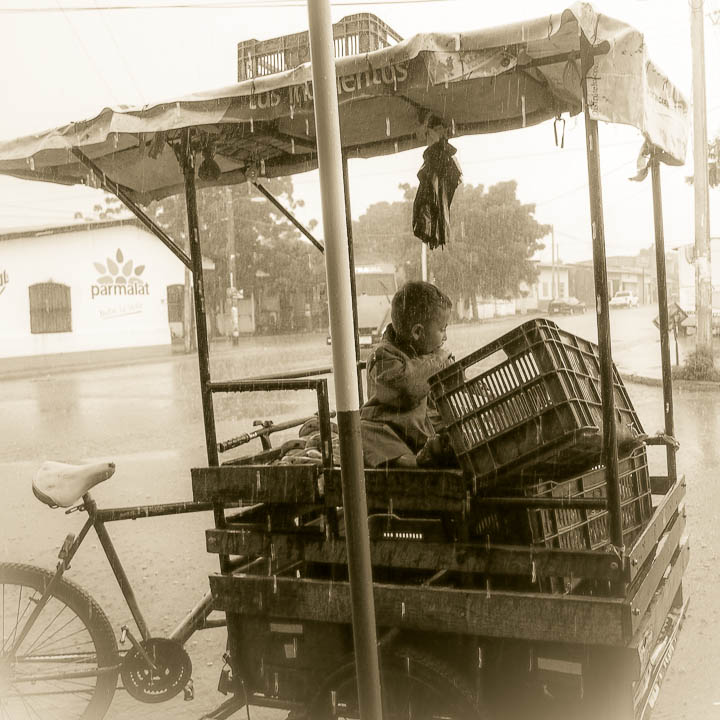by Anne Watcher on Sunday November 3rd, 2013 at 11:59pm
But then there is the distribution. On the one end of the spectrum, the supermarket sells cartons of processed milk - and on the other end, it is common to see a farmer wandering through the streets of the city on his horse, with a 5 gallon plastic pail - strapped to his saddle - one on each side. He stops when people enquire and ladles out the quantity requested.
Then there is the more refined milk vendor, who offers fresh milk while riding his bicycle fitted with a cart containing bright metal traditional milk containers. Question is - is he the farmer? If not - where does he get his milk from?
WELL - it couldn't have been scripted better as the milk vendor biked up the hill of our street early this morning. Watching with interest, he stopped directly in front of our side door. Within seconds a motorcycle packing 4 large dirty plastic containers - 2 strapped to each side - - - approached from the opposite direction. He hopped off of his motorcycle, exposing his legs heavily coated with mud from being with the cows in the field.
The two chatted for a bit and then went through the procedure of first emptying each of the containers of "freshly squeezed milk", into the vendors containers. First through a colander that the vendor held over a red pail - - - and then filtered again as the contents of the red pail were poured into the metal milk pails.
Then the money transaction took place. We have noticed before that Nicaraguans are meticulous bookkeepers. That was the case with this farmer as well. He opened his notebook and wrote down the calculations of his delivered product and price the vendor was to pay for that. Then the agreed amount of money was handed over.
Once done each went off to fulfill the rest of their day.
by Anne Watcher on Thursday October 10th, 2013 at 2:20pm
The words on the cart are so appropriate. Roughly translated it says: "Any excuse is good"
by Anne Watcher on Thursday October 10th, 2013 at 1:21pm
While in Costa Rica in 2008, Rob and I traveled to the small community of Guaitel, to see the Chorotega Indians make their pottery. Here in Leon we have found a connection once again to the Chorotega tribe.
Street view to the centre
Although now a suburb of Leon, the village of Sutiava once was a thriving individual town rich in history of these indigenous people. Today it is still a very close knit town where everyone knows everyone. You don't really need a sign on your business because people just know where to go for their fresh bread, vegetables and other needs.
You will know that you are "entering" Sultiava because of the beautiful boulevard that now separates the two lanes of Calle Ruben Dario. The people are warm and friendly and very accommodating to those of us who's Spanish leaves much to the imagination!
Point of Interest: "the neighbourhood's heavily indigenous population recently decided to change the name from the former Subtiava since they felt the former spelling was derogatory, according to the tourism office in Leon" from Viva Travel Guides
Casa Cural Sutiava 1743-1752
Sutiava has many sites and places to visit. One is El Tamarindon, the tree on which the Spanish hung the last king of the Chorotega tribe, Adiact. It is over 600 years old and can be difficult to find. As of 2012 only a portion of the tree remains.
Leading a revolt in 1725 lead to King Adiact's death. Interestingly, although they were forced to submit and eventually join Leon in 1902, the independent spirit of the people still prevails to the present.
Museo Adiact also contains many artifacts from years gone by. It is located on the main street, adorned with colourful murals so is hard to miss it.
The oldest church in Leon, Iglesia San Juan Bautista de Subtiava, is also found here. To appeal to the indigenous people so they would come to worship there a mural of the sun was added to the ceiling.
Iglesia San Juan Bautista 1700
A small but vibrant market can be found along the main street also. This is a great place to buy fresh fish and seafood caught that morning at Poneloya and Las Penitas. Also of great importance, this is where you catch the bus to the ocean!
Cultural buildings and various ruins also add to the appeal of spending some time in Sutiava. If you visit Leon and I hope you do, take an afternoon and explore Sutiava.
by Anne Watcher on Monday October 7th, 2013 at 11:58am
Being Canadian, weather is the subject of daily conversation. We have such a variety, with four very distinct seasons. Here in Leon and the rest of Nicaragua things do not vary that much, it is hot and dry or hot and wet.
As of today, October 7th, we are deep into the rainy season. This is Nicaragua's "invierno" or winter and it runs from May to November. We have been told that September and October are the rainiest, so far that has been true.
Hot, humid, sunny mornings turn into torrential downpours almost daily. One positive to living closer to the water is the almost daily breezes we get that make for a cooler evening and better sleeping conditions.
The other season is "verano" or summer and it runs from November to April. This is the dry season with the nicest weather being December to February, a good time for hiking and camping. As you go into the late summer, trees start to lose their leaves, vegetation dries up and the temperatures soar to high 30's C and beyond.
The Atlantic coast has a bit different climate in that it is much wetter and rains all year. Although it has a beauty all it's own, go prepared for moisture.
If you want a bit of "cooler" weather there are the central "highland" areas where temperatures may dip to 12C at night and cool cloud forests rest atop the volcanoes. Here is where you will find the coffee plantations, flourishing in the rich volcanic soil.
Point of Interest: Seeing we are still in the northern hemisphere we expected the seasons to be the same. Here in Central America however the seasons are named for their actual conditions not time of year. Therefore: wet=not so nice=winter, dry=nice=summer.
by Anne Watcher on Saturday September 28th, 2013 at 5:08pm
A strong, strange odour filled the streets of Leon where we were walking yesterday. It was a smell we were not familiar with but soon found out what the source was. As we rounded one corner we saw people out on the streets covering their faces while plumes of white smoke billowed out from the rafters.
Someone in the neighbourhood must have reported a case of dengue fever and the city was out to curb it before it spread. Crews were going house to house to fumigate and hopefully kill all the mosquitoes in the area.
As Rob and I stood and watched for a while we noticed that the men applying the spray were protecting their ears from the noise of the fogger but wore no protection for breathing in the fumes. Everyone seems to have an opinion as to the dangers vs benefits of this spraying.
One thing we have found out is that you are not required to have this done at your house. Some say it leaves a residue and smell on furniture and clothes, others say it is not that bad. We have also been told that if you don't have it done, the roaches may look to your place as a safe haven! You decide which you can handle the best.


